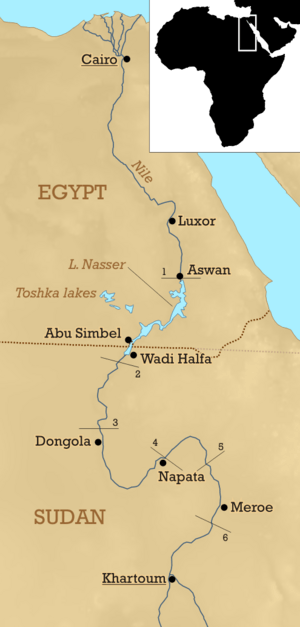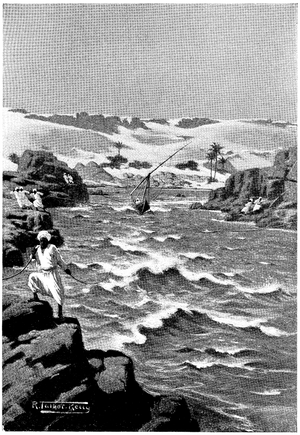Cataracts of the Nile facts for kids
The cataracts of the Nile are areas between Aswan and Khartoum where the water is shallow and flows quickly. The surface is broken by numerous small boulders and stones that lie on the river bed, as well as many small rocky islets. This is called "rapids or "white water".
River cataracts often go with a rapid down-drop of the river. They block the waterway, since boats cannot safely carry cargo though.
The six first cataracts of the River Nile were the main obstacles for boats sailing on the Nile in antiquity. Counted upstream (from north to south), the First Cataract is in modern Egypt; the rest are in Sudan.
- The First Cataract is near Aswan
- The Second Cataract (or Great Cataract) was in Nubia and is now submerged in Lake Nasser
- The Third Cataract is around Tombos / Hannek
- The Fourth Cataract is in the Manasir Desert and will be flooded by the Merowe Dam from 2006 onward
- The Fifth Cataract is near the confluence with the Atbara River
- The Sixth Cataract is where the Nile cuts through the Sabaluka pluton near Bagrawiyah
The word cataract comes from the Greek word Katarakhtes meaning "waterfall".
In ancient times, Upper Egypt extended from the Nile Delta to the first cataract. Further upstream, in what is modern Sudan, the land was later controlled by the Kingdom of Kush.
The cataract faces north, not south, because the river flows north, from Lake Victoria in the south.
The 1899 book "The River War" by Winston Churchill explains each of the cataracts.
- Photo links
- Second Cataract: Second Cataract Second Cataract
- Third Cataract: Third Cataract Third Cataract Third Cataract
- Fourth Cataract: Fourth Cataract
- Fifth Cataract: Fifth Cataract
- Sixth Cataract: Fifth Cataract Fifth Cataract
Images for kids
-
Second cataract in 1854 by John Beasley Greene
-
Sixth Cataract in 1908 by Sir Henry Rider Haggard
See also
 In Spanish: Cataratas del Nilo para niños
In Spanish: Cataratas del Nilo para niños









